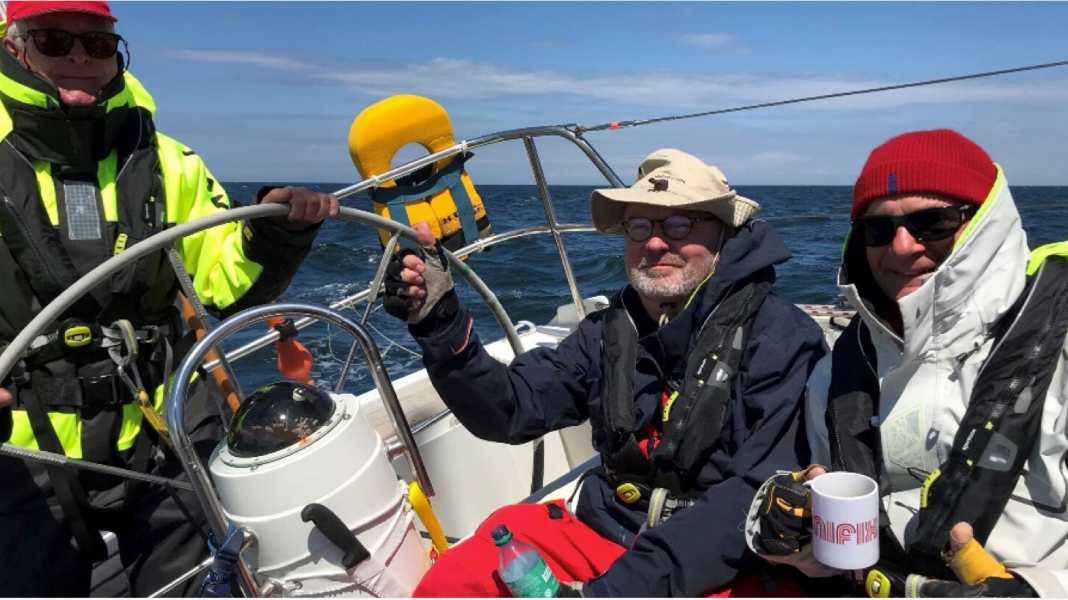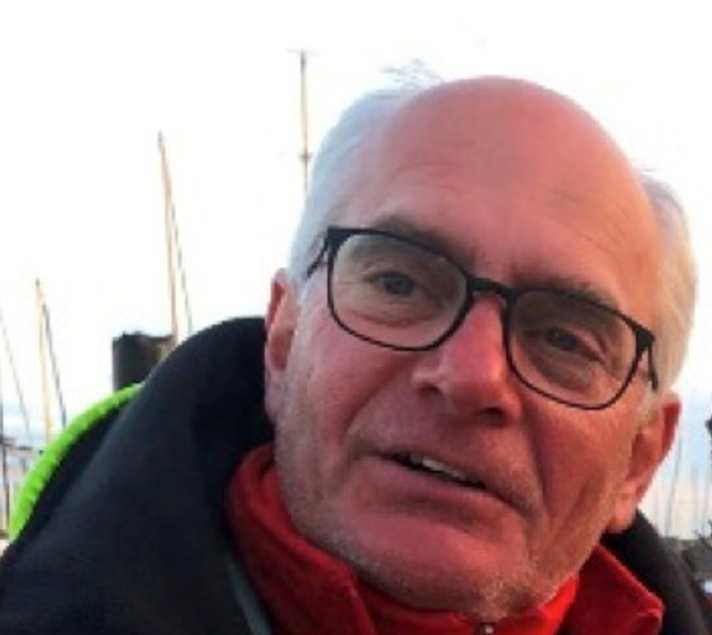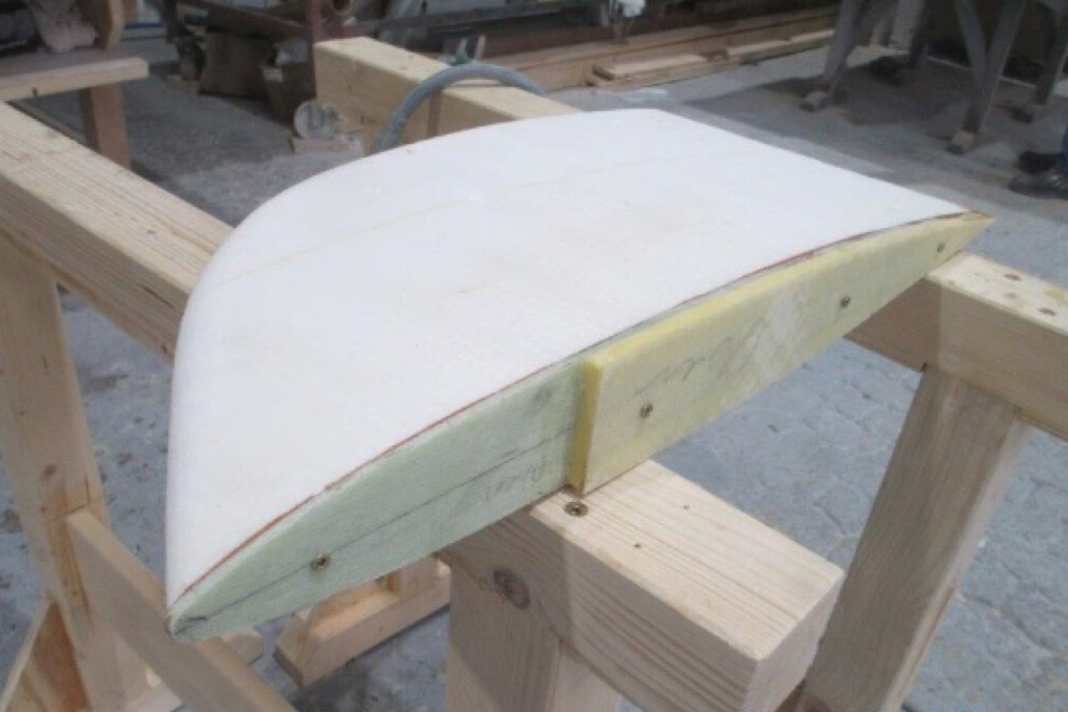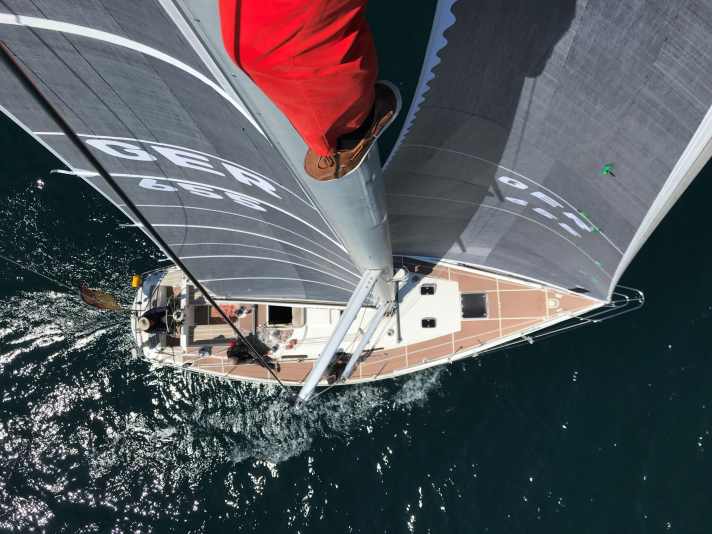
Lawyer Dirk Lahmann wants to sail in this year's Fastnet Race with his crew - without any in-depth offshore experience. The boat: The IOR 2-tonner "Snifix Dry", designed by Doug Peterson and built in aluminium at A&R in 1978. Lahmann and his wife took over the boat in 2011. In 2019, the project to race around the Fastnet Rock was born - not out of ambition for regatta silver, but because Lahmann and his crew felt that "this magnificent boat from the heyday of the Admiral's Cup and the IOR era simply deserves to round the legendary rock in regatta mode one day," says Lahmann.
But the preparation itself proved to be an immense challenge, especially due to the corona restrictions, and is a very worthwhile experience for all those who are also toying with the idea of taking part. And ambition is always one of those things. But read for yourself, Lahmann has written down his experiences in preparation here. He will report on the race itself in YACHT. By the way: The Fastnet Race starts on 8 August, the journey of the "Snifix" can be booked via the Race tracker be pursued.
By Dirk Lahmann:

There they are now on the salon table, six sealed envelopes with our tips for our ranking - at the Fastnet of all things! In this case, the participants are five men just over 60 and the author's brother Benjamin, who is 57, and we have no regatta experience. And our boat is only a little younger - but at least it has some regatta history. Of course, the first reactions were "now he's crazy" when we started this project in 2019, having never sailed in an ocean regatta before, but just for the Fastnet. And the answer to that was: Exactly, it's crazy, but that's why we're doing it! Crazy perhaps, but by no means naive or irresponsible. Whether it's a crazy plan or not, the nautical, technical and mental aspects are planned and prepared well in advance. And we're only doing it for the sake of the project, the myth of Fastnet Rock, without any ambition.
The Covid-19 effects are proving to be the most difficult (namely impossible) to manage for this "once-in-a-lifetime project". And so we have no idea how much luck we will have when we complete the obligatory World Sailing Offshore Training in Elsfleth on the second weekend in March 2020, because less than a week later, as we all know, Germany is in lockdown. Organising a seminar with several (!) people (!!) in one room (!!!) for several hours under these conditions and then splashing around together for several hours in a wave pool simulating the high seas, huddling together as shipwrecked people to form a "caterpillar", snorting and spitting water in the swell, as well as emitting unfiltered aerosols en masse in a confined space after successfully boarding the life raft - completely unthinkable for a long time after our course. We would have needed it for Rund Skagen 2020, which was intended as the first serious training session and qualification regatta. But as we all know, after repeated and painstaking attempts by the regatta organisers to somehow get the 2020 North Sea Week off the starting line, it had to be cancelled in frustration.
But we didn't want to be frustrated by this, so navigator Willie and I defiantly set off from Cuxhaven on Whit Monday 2020 in corona-approved double-handed mode for our very own 550 nautical mile round Skagen. You need to know that our "Snifix dry" is totally unsuitable for short-handed sailing: large, heavy, non-rollable headsails (top rig with "front drive"), separate steering cockpit, all winches (with the exception of the spinnaker winches, great, we need them the least with two of us) as well as all halyards and spreaders and the mainsheet out of reach of the helmsman.
Nevertheless, the trip was a great success and left us wanting more, the North Sea and Baltic Sea were reversed in the week after Whitsun 2020, the North Sea was peaceful, off Blavandshuk we even had to anchor for hours with the current against us in a calm to avoid being driven home, east of Jutland there was a lot to do - especially at night - with a lot of pressure in the air, showers and poor visibility, especially in the narrow passage west of Læsøs, and the wind shifted to the right - all from the front. Our arrival in Laboe after five and a half days therefore did not recommend us for the Cuxhaven-Kiel Blue Riband, but the experience we gained was considerable (next time we will certainly sail closer under the east coast of Langeland) and Willie and I were very exhausted and happy when we arrived.
In general: Willie, I need to say a few more words about him. Willie comes from Franconia, lives in the Taunus, and he's not actually a sailor - he's actually a glider pilot. Of course he can sail, he learnt back in the 80s in Brittany, but hasn't really practised much since then. We've known each other since we lived on the same floor of a nondescript apartment block near Würzburg for a year during our studies. And in 1992, Willie was part of the crew on my first Caribbean charter trip. Since then, however, his logbook has been full of blank pages. But he loves Brittany, England and the English, he prepares the best roasted porridge after the night watch, knows, finds and studies books and all other sources that nobody else comes across, in English and French, especially about everything to do with yachts and seafaring. He has never done anything like this before - but he was clearly the first choice as navigator for our project! His tablet has been running gribfiles for 18 months, which he painstakingly downloads from somewhere, and he created a "roadbook" for our Fastnet at the beginning of last year, which he has been constantly adding to and condensing ever since with everything he can find out about the course, the coasts, shallows, currents, races and overfalls.
But having Willie on board is also an expensive pleasure, because he has investment suggestions that no one else would come up with. He soon took offence at the rudder blade of our "Snifix dry": too short and blunt, it needs an extension with an optimised edge curve, says the aerodynamically experienced glider pilot.





To understand this suggestion for improvement, you need to know our "Snifix dry" better. By the way: Explaining the dodgy name would go too far here, if you are interested you can read about it at www.snifixdry.com, but the site is still under construction. Back to the "Snifix": She is a very unusual yacht, built in 1978 by A&R in aluminium according to plans by Doug Peterson. The client and first owner, Fredi Heins, had a special task: As a man from Bremen, he wanted an IOR 2-tonner that was not only suitable for regattas, but also as a family boat with a variable draught for the mudflats of his home waters on the North Sea. This required compromises. So the boat was designed as a centreboard with a somewhat chunky wide fixed keel with a draught of 1.40 metres and a lead centreboard that has a draught of around 2.40 metres when sailing. With our home port of Bremerhaven, we wouldn't want to do without it, because the gain in cruising alternatives and the significantly larger time window for draught-critical passages before and after high tide are a great thing, and we can easily fall dry in soft ground. Following the Fastnet, we can also plan a fine trip along the historic Normandy coast with "Snifix dry", which would not be possible with 2.40 metres.
But you pay a certain price for this in terms of performance and especially for the rudder blade. At 1.40 metres, it is actually too short, but relatively wide, and simply cut off at the bottom behind the skeg. Not an option, says Willie. He researches which rudders and profiles Doug Peterson drew on comparable yachts at the time, and convinces me to dip into the till again and order a fine rudder extension of around 35 centimetres in the optimum NACA 0012 shape and with a fine edge curve from Kamlade in Bremerhaven, where "Snifix dry" has been well looked after for years, because we are known to be quite unambitious in our work. That's how it's done, from hard foam and GRP, and because the boat builders are currently at work, the aft edge of the entire rudder blade is also finely filled and smoothed at Willie's insistence, as the shipbuilders at A&R were not as sensitive as our Willie 43 years ago.
For category 2 regattas, the Offshore Special Regulations also require, among other things, a bright orange area of at least one square metre on the ship's belly so that the yacht can be seen more easily from the air if it is thrown onto its back. We don't let ourselves get carried away, and soon our entire fixed keel and the chic new rudder blade extension shine in this colour, which is completely in line with the design concept of our "Snifix dry" anyway: any colour is allowed as long as it is red or orange, right down to the tea towels and clothes pegs. Looks smart, our elegant lady in a combat suit - and yet we're keeping our fingers crossed that no one will see it except in a crane or when dry.
Our minimum draught is now 1.75 metres and our hard foam afterburner on the rudder blade is not designed to keep the yacht on it. I have therefore already mentally prepared to shred the beautiful hard foam extension during the post-Fastnet Normandy trip. To further improve our performance, the men's crew will meet in the hall on a weekend in March and smooth out the fresh underwater paint by hand. Frank Kamlade just rolls his eyes when he hears about it - all that lovely new antiflouling thinned out again.
"Snifix dry" takes it in its stride, as it is familiar with such gentlemen's adventures of going on long-distance offshore races without much crew experience. First owner Fredi Heins had already pulled off such a feat in 1981 and entered the Edinburgh Race with a random crew with no experience on board. At the time, a report on this trip appeared in YACHT 06/1981 under the title "Port is the better bow after all", as it turned out that the boat ran noticeably better on the left than on the right.
When it comes to preparing the boat, there are many more things to do, and I find myself in the practice so aptly described by Boris Herrmann with the bon mot "ocean racing is working through lists", because there are already quite a few of them even in our comparatively small project. Many things are just administrative work, others are expensive. For example, we now have a cosy, inflatable eight-man emergency accommodation under the helmsman's feet for a crew of six, the old six-man island did not meet the high seas requirements, and our own experience during safety training made it an easy decision not to get involved with a six-man sardine can for six adults - the manufacturer's specifications and approval criteria are very optimistic here and it is therefore better to take a size larger than is apparently sufficient according to the number of crew. New waistcoats with AIS transmitters, Epirb and similar useful things are added, finally a closer look is taken at the actual capacity of the automatic bilge pump (not enough ...), there is an emergency kit with hardcore tools for mast breakage and water ingress, and with medical advice also a great emergency first-aid kit including sewing kit for lacerations. We had already learnt how to mend chicken legs during the training courses in Elsfleth.
In addition to the obligatory additions to the equipment, there are the optional ones - and this is where things get really serious financially. If we're starting out with such an optimised underwater hull, we can't afford to have any problems on deck with our completely unambitious plans. So the author takes the appropriate opportunity at dinner with the best wife of all and co-owner to talk about the sails, like this: They were still in good shape, but they wouldn't last as long as we wanted to sail "Snifix dry" anyway, and it would be better to get new sails now rather than later, and preferably made of carbon laminate, so you know what you have, and - and this is the bait - they are also lighter. The best wife of all is surprisingly understanding - as she usually is in the context of her husband's ego trip - and takes the bait. After obtaining a few quotes, lots of advice, research and phone calls, we finally sit down at Jens Nickel's meeting table in Stade in February 2021 and order a smart carbon-fibre glued boat. With the addition of new cockpit instruments, an electronic logbook recorder, some running rigging from the Dyneema department and small parts of all kinds, it all adds up quite nicely. What luck that we are travelling without any ambition - that would be expensive!

While the nautical and technical preparations are progressing well and according to plan, and even the crew are working on their physical fitness on rowing machines, mountain bikes, horizontal bars or simply with push-ups, through no fault of their own, the training and regatta practice is still struggling: we are scratching our hooves, but the stable remains closed due to coronavirus. At the turn of the year 2020/21, optimism for the new year is generally spreading thanks to the start of vaccination, and the organisers of the North Sea Week announce that the Edinburgh Race will take place for the last time in 2021. We report immediately. But now the British mutation comes into play, the numbers shoot up again, in Germany the politicians make strange decisions in February and offer the prospect of a family-friendly "relaxed" Easter after the messed-up Christmas, while the British in Edinburgh are unsettled and cancel the race. The North Sea Week reacts and makes new plans: the HOT is launched, the Helgoland Offshore Triangle, a regatta in a large circle around Helgoland, around 400 nautical miles, especially as a qualification regatta for the Fastnet - we report immediately. But things turn out differently, the incidence values cannot be brought under control, the vaccination campaign is slow to get going, Easter is again a bust, political statements soon indicate that openings are not to be expected at Whitsun either, the organisers of the North Sea Week have to draw their conclusions from this, not least with regard to the necessary advance investments for the event, and also cancel the 2021 event. The fact that the manoeuvre training originally planned for Easter will also be impossible is the easiest thing to accept in view of the sad weather conditions at Easter.
A certain frustration is spreading. Of course, we know and are grateful that we have luxury problems that others would like to swap with in these long Covid months when we only have to cancel planned sailing dates, but things are getting tight for us now because we have not yet been able to sail our qualifying miles. In this respect, the regulations for the Fastnet stipulate that at least 50 per cent of the crew must have sailed at least 300 ocean racing miles together on the registered boat. We have not yet had this opportunity, and with the cancellation of the North Sea Week we are now at a loss on this point, as there are no suitable and reliable alternatives in good time.
However, we are not the only ones affected by the problem, and our friends at the organising RORC are showing fine British pragmatism and great flexibility in somehow reconciling corona and their great traditional regatta. For example, the recognition period for the aforementioned offshore safety training courses has been extended to seven years. Normally, they are due every five years - but no courses have been held in Europe since 2020. And instead of regatta miles, the RORC is also prepared to recognise suitable private trips as a qualification. The verdict of the "Snifix dry" crew on the alternatives I put to the vote of up-and-downs to Norway or Grimsby, a private new edition of Skagen Rund, or a 450-nautical-mile North Sea triangle, is overwhelmingly in favour of the latter, planned for the beginning of June. We are keeping our fingers crossed that such projects will be permitted again at least until then. After all, there are six of us from six households - this hasn't been possible for months.
And finally, in May, the tide turns. The incidence values fall, fall below the relevant threshold values, and restrictions are eased, especially for outdoor team sports. What we have in mind is sport, and outdoors, and our watch plan ensures, even requires, that there are never more than two of us together below deck. So we can finally set off, albeit only with a crew of four for work reasons, but that's enough.
We are lucky in another respect: the weather is also changing, and after a cold and rainy May, a sustained period of fine weather is on the horizon for the beginning of June.
Under these conditions, we set off on our qualification trip on Sunday, 30 May 2021, at high tide at around 17:00 in excellent conditions in Bremerhaven. It should take us down the Weser, then "round to the left" to the west to the height of Terschelling, there north around two gas production platforms, then northeast to Horns Rev and on to Blavandshuk on the Danish coast, following the "Slugen" between the wind farms there briefly to the east-southeast, and then straight south back to Bremerhaven, a total of around 450 nautical miles over ground.
This story is quickly told, it was a super trip, pure sunshine as announced, only the temperatures on the North Sea were still shady, while it was rumoured that midsummer had already arrived on land. Overall less wind than expected, but from a favourable direction, roughly north-east. We have a lazy time, can sail practically everything with the formidable new G2, and the expected cross to Terschelling is also omitted, instead we have a nice spinnaker reach from Wangerooge to the south of the Borkum Riff wind farm, where we then have to tack further and the spinnaker fun ends. The homerun on a southerly course then becomes really fast, because "Snifix dry" shows what she's made of under G2 in half-winds of 5-6 Beaufort, even on starboard tack, because even after 40 years the left cheek is still her favourite for some unknown reason. The measurement revealed that her hull was "unusually symmetrical". I don't know, sorry: Albatros, where the differences come from - in the end, despite all the science, sailing is obviously still magic - even beautiful.
We reach Bremerhaven again early in the morning on Thursday, 03.06.21, at around 02:00, the last few miles under motor because we arrived at Red Sand at the most unfavourable time imaginable at high tide and so have the rest of the way ahead of us against the ebb current as the wind drops. However, our 300 nautical mile qualifying barrier had already been broken shortly after Slugen and we had to return home, not least for professional reasons.
Nevertheless, it remains exciting until the end. We fear that our fastnet has not yet been saved, because while it seemed at the beginning of the year that the UK would become the destination of choice in 2021 due to the rapid progress of vaccination there, where all corona restrictions were most likely to fall, the picture is reversing again - the UK is once again becoming a problem case due to the "Indian mutation" and is now a "mutation risk area" from a continental European perspective. The English entry restrictions remain in force, and worse still, the regulations for travellers returning from the UK are being tightened with long quarantines. This is also a blow to the RORC, as it is not possible to sail from Cowes to France with a 450-boat fleet under these conditions. But the organisers remain steadfastly on the ball. They have set up a second regatta office in Cherbourg, at least for the non-UK participants, and are offering to move the boats there before the race, take delivery there and brief the crews. Then, on the day before the start of the Fastnet, a presumably very large armada is to sail the 75 nautical miles across the Channel to Cowes without mooring there. Consequence: no entry to the UK and therefore no entry from the UK when returning to Cherbourg. So it will practically be a flying start to the regatta course. They are working on a quarantine camp solution in Cherbourg for the UK participants. We are keeping our fingers crossed that all the necessary officials are on board!
"Snifix dry" and crew are now prepared, since 11 July she has been transferred to Cherbourg, again in pairs. We have no idea whether our tips in the sealed envelopes have any relation to reality, as we have not been able to measure ourselves against others, neither in terms of our sailing skills nor in terms of the chances that our measurement gives us. But it doesn't matter, because - I don't know if I've already mentioned this - we are travelling to the Fastnet without any ambition, just for fun.

